Last updated on May 26th, 2025 at 08:04 am
There are many great reasons to visit China. Its rich history, diverse culture, dynamic cities, and breathtaking landscapes offer an array of experiences for travelers.
While many travelers to China prioritize visiting iconic landmarks such as The Great Wall of China, the Terracotta Warriors in Xi’an, and the Hallelujah Mountains in Zhangjiajie National Park, lesser-known gems like the megacity of Chongqing and the 3 Natural Bridges of Wulong Karst often get overlooked.
In this China travel guide, we’ll provide a detailed and easy step-by-step explanation of visiting the Three Natural Bridges from Chongqing by public transport. And if you like saving money, then you have definitely come to the right place!
By the end of this article you’ll discover that you don’t need to be an experienced traveler, nor do you have to spend a lot of money on a private tour to visit Wulong Karst from Chongqing.
HOWEVER, if you’d prefer the convenience of a guided tour, you can join the top-rated Wulong Karst day trip from Chongqing. Escape the hustle and bustle of the city and immerse yourself in the breathtaking natural beauty of Wulong Karst National Geology Park and Fairy Mountain – all in just one day.
Where Is Wulong Karst?
Wulong Karst is a stunning natural wonder located nearly 200 kilometers from the city of Chongqing, China.
Many people have never even heard of the municipality of Chongqing. Yet, it is nearly the size of Austria with a population of over 32 million people!
A UNESCO-listed site, Wulong Karst is known for its unique landscape, featuring natural bridges, caves, and gorges. In this article, we will explain how to visit the most famous attraction – The Three Natural Bridges which are Tianlong Bridge, Qinglong Bridge, and Heilong Bridge.
If you are not sure what karst and a natural bridge mean then allow us to explain. A karst landscape is an area with natural features sculpted from rock. Examples of these geological features are sinkholes, caves, and natural bridges. These bridges are formed over time through erosion, creating distinctive arch-like structures within the landscape that look just like a bridge!
Check out our 2-week China itinerary – your guide to the perfect travel route through China’s top destinations. With insider tips and the best transport options included, you’ll spend more time exploring and less time figuring things out. Or, if you prefer to customize your own journey, be sure to read our top travel tips to help you best prepare for your China trip.
Chongqing Municipality
Chongqing ranks among the top cities in the world for most skyscrapers. If you imagine that New York and Hong Kong had a baby, it would look like Chongqing!
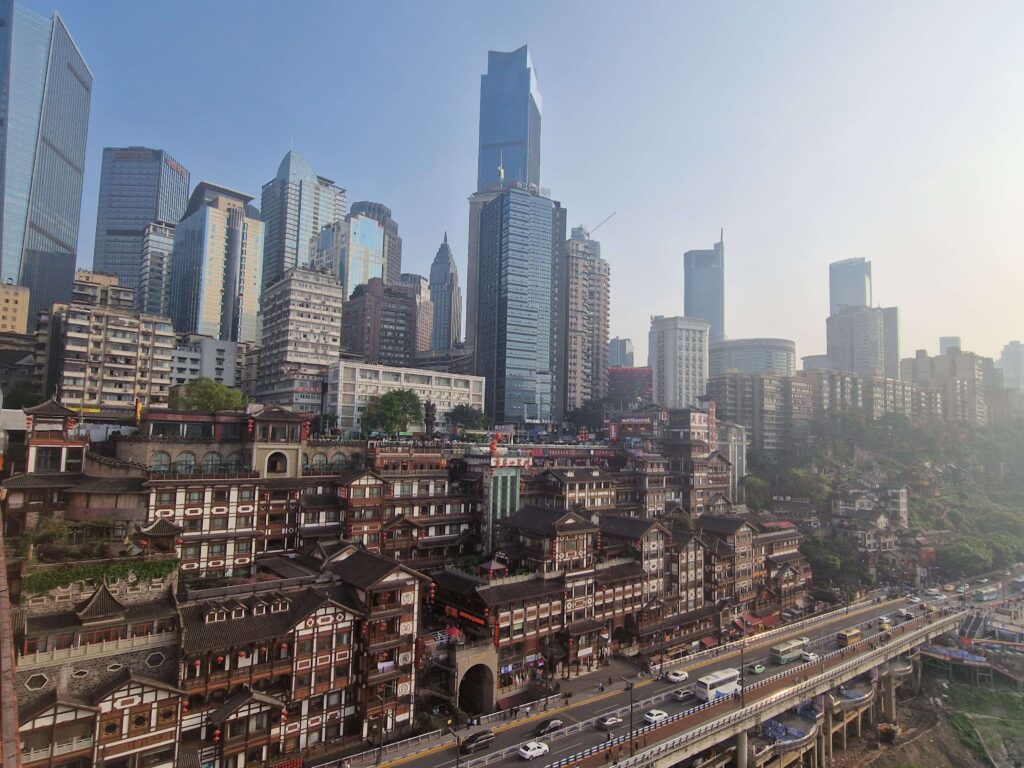
Provided that time permits, we highly recommend including a visit to Chongqing. There are many great things to see in Chongqing, and one of the most popular activities is a Wulong Karst day trip.
Chongqing is the starting point for one of China’s most popular attractions – A 4-day cruise down the Yangtze River from Chongqing to Yichang surrounded by breathtaking taking landscapes.
Don’t miss this amazing adventure and start planning your trip now!
Getting To Wulong Karst From Chongqing
When we were planning our 30-day China Itinerary, we read a lot of information online saying the best way to get to Wulong Karst from Chongqing is by private driver (the most expensive option) as the process of using public transport was very complicated. Other websites stated that the only way is by bus.
However, both are far from the truth and once we were in Chongqing we realized that the process of getting to Wulong Karst was actually quite simple. So, we’re here to share the latest information we gathered firsthand.
To travel from Chongqing to Wulong Karst by train, you’ll need to follow two steps. First, you’ll take a train, and once you arrive in Wulong, you’ll take a bus to the Wulong Karst Visitors Center, where you will buy an entrance ticket.
Be sure to explore our list of the 10 Best Places to Visit in China for an unforgettable journey through the country’s most iconic and breathtaking destinations.
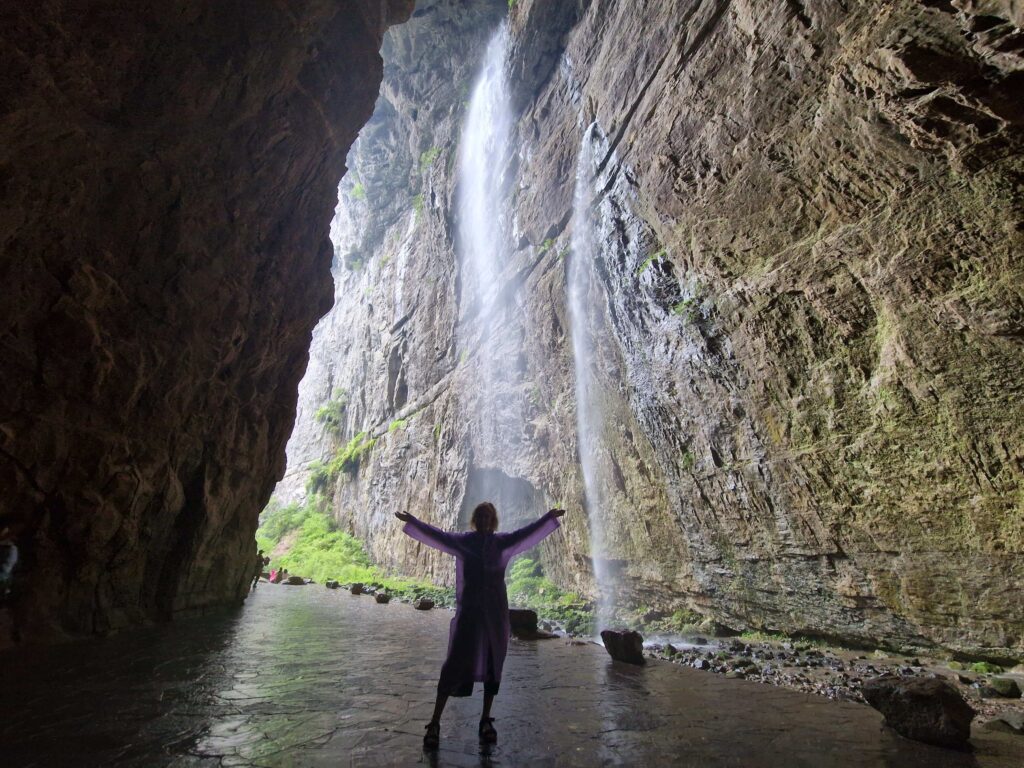
Chongqing North Train Station to Wulong
For a convenient Wulong Karst day trip from Chongqing, taking the train is your best bet. A high-speed train now operates several times daily from Chongqing North Train Station to Wulong Town. It is possible to take a bus, but this trip takes up to 4 hours.
To reach Chongqing North Train Station via metro, you have two options: you can either disembark at Chongqing North Station North Square or Chongqing North Station South Square. You can get there by taking the Blue Line 3, Orange Line 4, Purple Line 10, or the Brown Loop Line.
The easiest way to book your train ticket is by using the app – Trip.com, this is an essential app when visiting China. Depending on what train you choose, the journey takes from 2 to 3 hours and tickets will cost around 10 yuan per person.
China Travel Tip – Make sure to bring your passport as this will be your train ticket!
Wulong Railway Station to Wulong Karst By Bus
Once you arrive at Wulong Railway Station the next step is just as easy. Once you exit the train station, turn right and walk a short distance to a line of waiting buses, these buses will take you directly to the Wulong Karst Visitors Center which is located in a town called Xianv.
As all signs will be in Chinese, you’ll need to rely on visual cues. Look for a blue bus displaying the sign shown in the photo below. This sign translates to “Fairy Mountain,” which is also the location of the Wulong Karst Visitors Center.
Use Alipay to translate and ask for directions. If unsure, approach bus drivers directly for guidance and avoid asking tour guides or taxi drivers who will suggest taking the more expensive option of a taxi instead.
The bus journey from Wulong Train Station to Wulong Karst Visitors Centre takes approximately 30 minutes and costs 10 yuan per person one way. We are aware that the 2-plus hour train journey is the same price as the 30-minute bus trip, common sense isn’t always common!
Along the way, you will have a scenic drive with stunning views as you ascend into the mountains and above the clouds.
- Use the following link to learn about how the Alipay Translate tool works along with other essential apps for your trip to China.
Purchase Tickets at Wulong Karst Visitors Centre
After half an hour, the bus will stop in the town of Xianv in front of a large gray pyramid-shaped building, this is the Wulong Karst Visitors Centre. The location is not Wulong Karst itself but where you will purchase your entrance ticket.
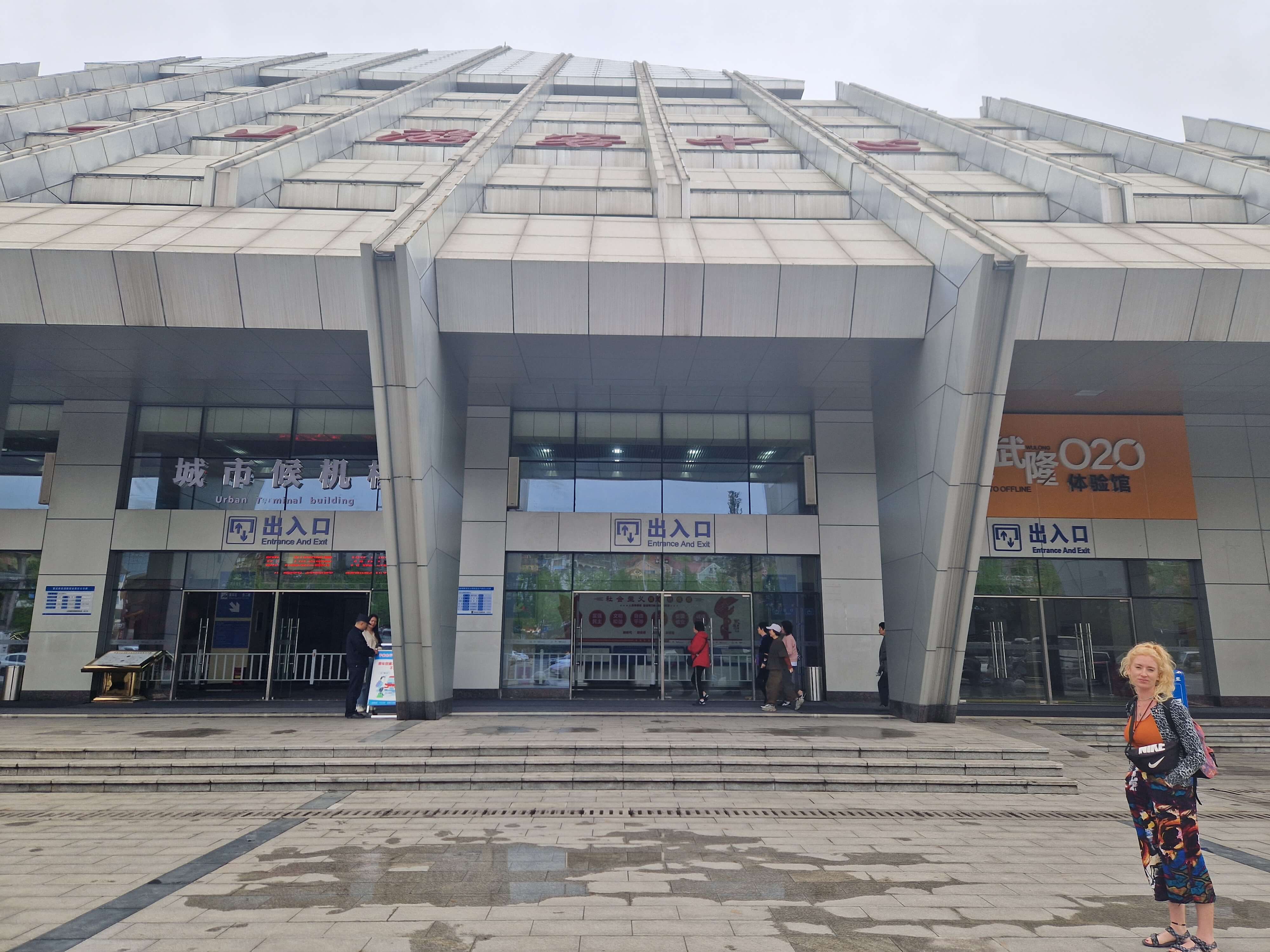
Proceed inside through security and make your way down the escalator. Turn right at the bottom towards the ticket office and present your passport to purchase a ticket. The entrance fee is 125 yuan per person from March to October and 95 yuan from November to February.
Remember, your passport will again serve as your ticket, which you’ll present at the check-in office in Wulong Karst.
The last thing to do now is make your way down another floor, where you will find the free shuttle bus that takes you to the entrance of the Natural Three Bridges in Wulong Karst.
This bus trip takes around 10 minutes and you will know you are close when you pass the Transformer statue of Bumblebee!
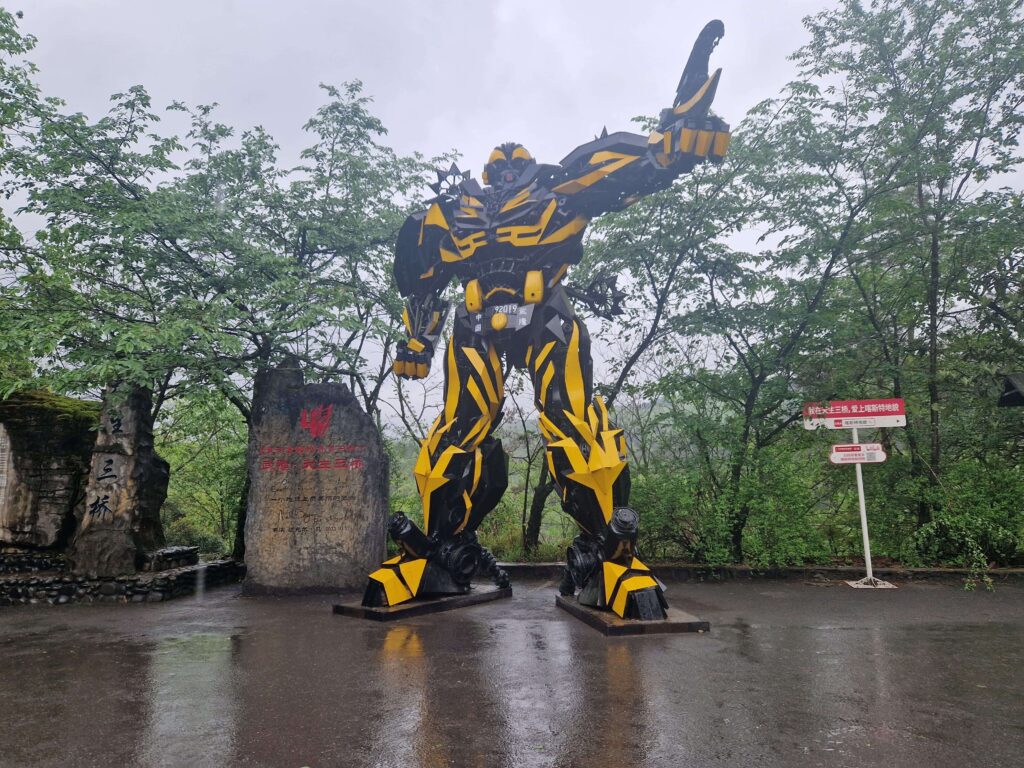
Wulong Karst gained international recognition as The Three Natural Bridges appeared in the movie “Transformers: Age of Extinction,” the fourth installment of the “Transformers” film series.
After the bus stops at the car park, head back toward the Bumblebee transformer statue for approximately 100 meters to reach the check-in area. Show your passport, which is your ticket, and then follow the path to the elevator that brings you down into the gorge.
Use of the shuttle bus and the elevator is included in your entrance fee to Wulong Karst.
Hiking the 3 Natural Bridges
The hike through the Three Natural Bridges in Wulong Karst features some of the best natural landscapes in the world. This is an easy and short 2-kilometer walk mostly on flat terrain, except for the initial descent through the first natural bridge – Tianlong Bridge.
The trail follows the Furong River and along the way, you will come across the 3 Natural Bridges (Tianlong Bridge, Qinglong Bridge, and Heilong Bridge), Fairy Mountain Temple, waterfalls, more transformer statues, and many spectacular views!
There are also plenty of toilet facilities en route.
Tianlong Bridge: Tianlong translated means Sky Dragon and this impressive natural bridge is the first attraction you’ll immediately see after getting off the elevator.
Spanning 235 meters wide and nearly 150 meters in height, it is the start of the 2-kilometer trail.
To get down you’ll descend a staircase through Tianlong Bridge to the track below. On the way down make sure to keep an eye out for the “Elephant statue” a natural rock formation that resembles an elephant.
Once you reach the bottom of Tianlong Bridge via the staircase, you can walk a short distance to the left, where, weather permitting, you can enjoy a hot air balloon ride. Even if you are not taking a balloon ride, it is still worth the short stroll.
Then, return to the main track to visit the Fairy Mountain Temple before proceeding to the next natural bridge.
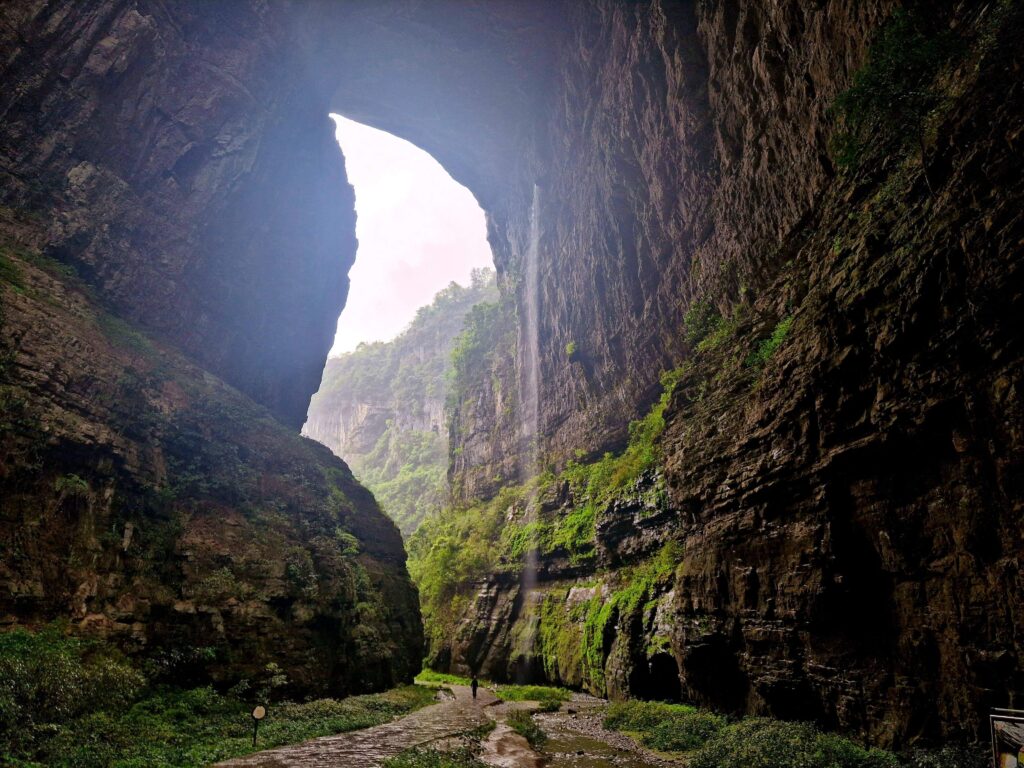
Qinglong Bridge: The second natural bridge is an impressive 280 meters in height and nearly 130 meters wide, the name means azure dragon, a mythical creature in Chinese culture.

When viewed from the front, Qinglong Bridge resembles the blade of a sword. However, once you have walked through and looked back, it will have transformed into the resemblance of a salmon leaping from the water.
Heilong Bridge: Saving the best until last is Heilong Bridge, which translates to “Black Dragon Bridge”. This is the last and largest of the three natural bridges in Wulong Karst.
Heilong Bridge rises nearly 225 meters in height and has a width of 200 meters. This is another spectacular natural bridge that is most famous for the many waterfalls that come through the cracks in the wall.
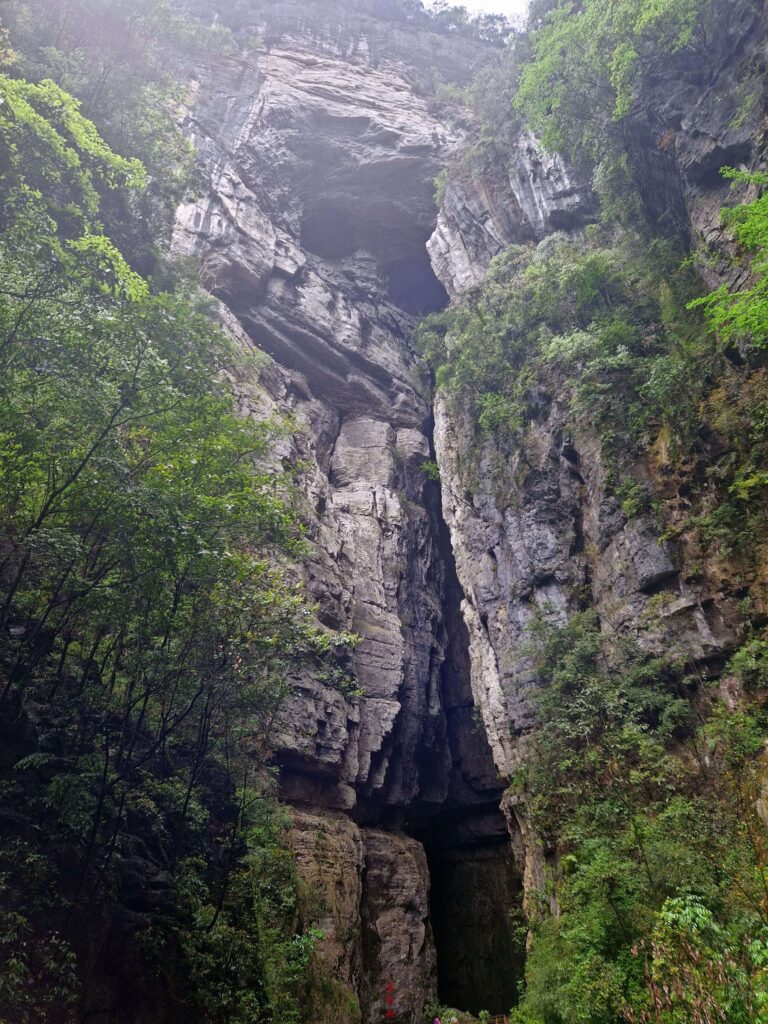
After walking through, don’t forget to turn around and admire the “guardian” of the cave, a natural rock formation resembling King Kong.
For another of our favorite China Attractions, find out how to get to Leshan Giant Buddha from Chengdu – the largest stone Buddha in the world!!
Return to Wulong Karst Visitors Centre
Although the 3 Natural Bridges trail in Wulong Karst is only 2 kilometers long, it took us nearly 2 hours to complete due to the many fantastic photo opportunities, as well as a packed lunch picnic along the way. Read more about – How to eat cheap around the world.
At the end of the 2-kilometer walk, you’ll reach a “sightseeing car station.” This is not a sightseeing route but rather a paid shuttle transfer at 15 yuan per person that takes you 500 meters further to the transfer shuttle station.
Just walk the extra 500 meters, it’s not hard! Once you are at the transfer station walk through all the food stalls to take your free shuttle bus back to the visitors centre.
China holds three spots on our list of the Best Landmarks in Asia – how many have you checked off your travel list?
Wulong Karst to Chongqing
Once at the Wulong Karst Visitors Center, you will see many different colored buses of tour groups. Find the same blue bus that you took initially, there will be two buses there. One with a 10 Yuan fee and another with an 8 yuan fee. You need to take the 10 yuan fee bus to go back to Wulong train station. The 8 yuan bus is a different line and doesn’t go to the train station.
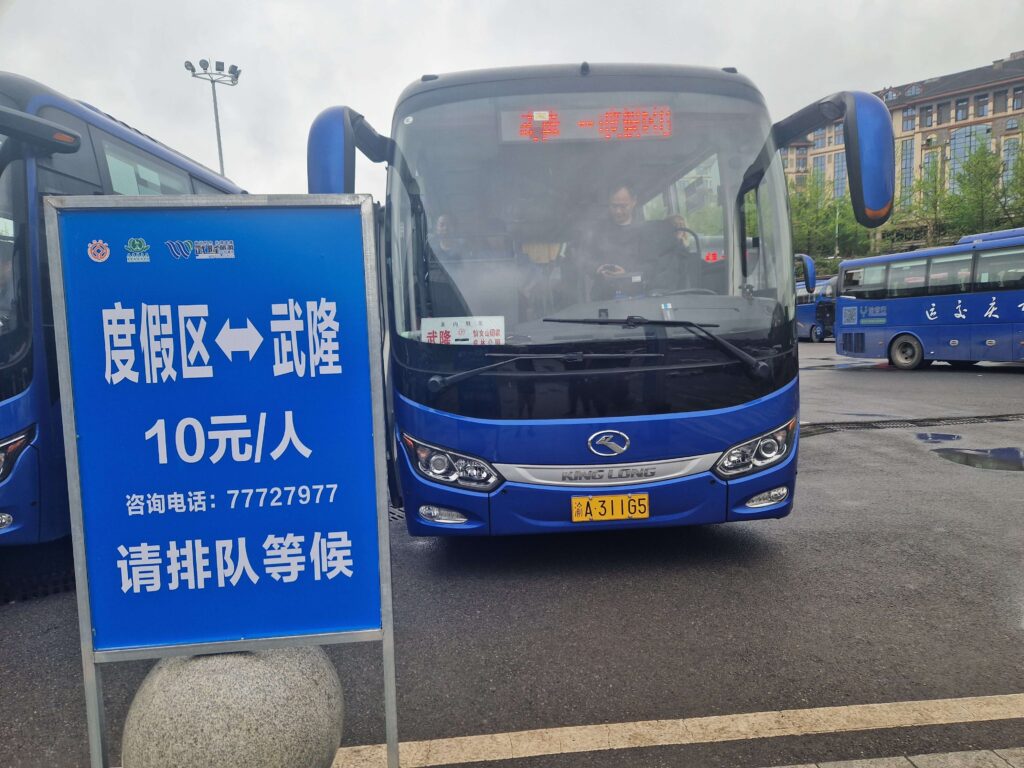
Again if in doubt, use Alipay to translate and simply type in “wulong train station”. Chinese people are very friendly and even though they may not speak English they will try and help you.
The bus back takes another 30 minutes with two stops, first at the Wulong Bus Station and two minutes later at your stop – Wulong Train Station where you will get off and take your return journey to Chongqing North Train station.
Despite not being advertised on Trip.com, we discovered an earlier train available than our booked one. We successfully canceled our 19:10 tickets with a full refund and purchased new tickets for the 16:16 train, although we had to forfeit our seats and stand for the two-hour journey…..
On your visit to China, you do not want to miss the chance to visit Zhangjiajie, a UNESCO World Heritage site famous for its breathtaking scenery that inspired the “Avatar” films. Continue reading all the way to the end as we share details about traveling from Chongqing to Zhangjiajie and our final tips for visiting Wulong Karst from Chongqing.
In the meantime, if you find our page helpful, we would greatly appreciate your support. If you can afford it, consider treating us to a beer – Sláinte!
Wulong to Zhangjiajie National Park
If Zhangjiajie National Park is on your China itinerary (and it definitely should be!), we recommend staying in the city of Wulong, which is about 40 kilometers (roughly 25 miles) away. This way, you won’t have to go all the way back to Chongqing. Otherwise, you’ll end up taking the same 2-hour train ride to Zhangjiajie via Wulong, as we found out!
Zhangjiajie National Park, another UNESCO World Heritage Site is known for its towering sandstone pillars that inspired the fictional Hallelujah Mountains in the movie Avatar. The park boasts over 3,000 of these towering peaks, which reach heights of up to 1,000 meters. Sounds worth visiting right?
Other nearby attractions to Zhangjiajie National Park include Tianmen Mountain, accessible via the world’s longest cable car ride. And if you’re looking for an adrenaline rush, don’t miss the famous Zhangjiajie Glass Bridge, but be aware, it might leave your legs feeling a bit wobbly!
The unique landscape of Zhangjiajie National Park is unlike anything you’ve ever seen before, and it’s definitely worth a visit! Plan to spend at least 4 days exploring the area to fully enjoy everything it has to offer.
AVOID THE INFAMOUS LONG QUEUES IN CHINA AND PREBOOK YOUR TICKETS TO THE SPECTACULAR AVATAR MOUNTAINS IN ZHANGJIAJIE NATIONAL PARK.
Visiting Wulong Karst Summary
Although we were reluctant to visit Wulong Karst due to the horror stories of how to get there and the prices of a private tour, we are so happy that we visited one of China’s best attractions, and highly recommend that you visit too!
Here are a few final tips and considerations to keep in mind when planning your visit to Wulong Karst from Chongqing.
- The most important thing to take from all of this is to bring your passport! Not only does it act as your train ticket, but it will also be your entry ticket once you have purchased the entry fee.
- The Three Natural Bridges in Wulong Karst seem to be quite a wet place, it’s wise to pack rain gear, a dry bag for your valuables, and even an extra t-shirt and socks in case you get soaked.
- If you do not have rain gear you can buy a disposable poncho in the visitors’ center or from the vendors by the entrance gate.
- The park is open from 09.00 in the morning, until 4 o’clock (16.00) in the afternoon.
- Be sure to give yourself enough time to catch the last train back to Chongqing from Wulong, and avoid the possibility of being stranded in Wulong.
- Having said that, it is possible to stay in Wulong Town or Xianv and visit other attractions such as Furong Cave, Longshuixia Gap, and Fairy Mountain.
- If you’re planning to visit Zhangjiajie National Park, consider staying in Wulong instead of backtracking to Chongqing.
- Don’t forget to buy Travel insurance, get a FREE quote below
China Travel Tip – Even with the luck of the Irish, things can still go wrong. World Nomads Travel Insurance is our top choice for travel coverage. With the best transparent fine print in the industry, it’s no wonder they’re ranked number one. Don’t let your China adventures turn to mishaps and get a free quote today!
Are you getting excited about your trip to China yet? Check out the following links to start planning your trip of a lifetime today. It’s free, what are you waiting for?!
If you have any questions then leave us a comment below, and don’t forget to check out our socials for our latest adventures.
Slán go fóil
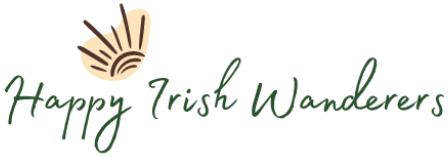

This post contains affiliate links. If you click on the links to make a purchase, we will earn a small commission. This is at NO EXTRA COST to you. This is a free way to support us and allow us to continue to create inspiring adventure travel guides.
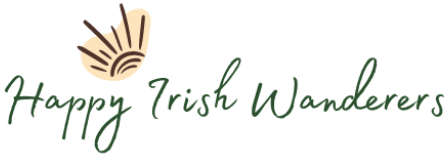
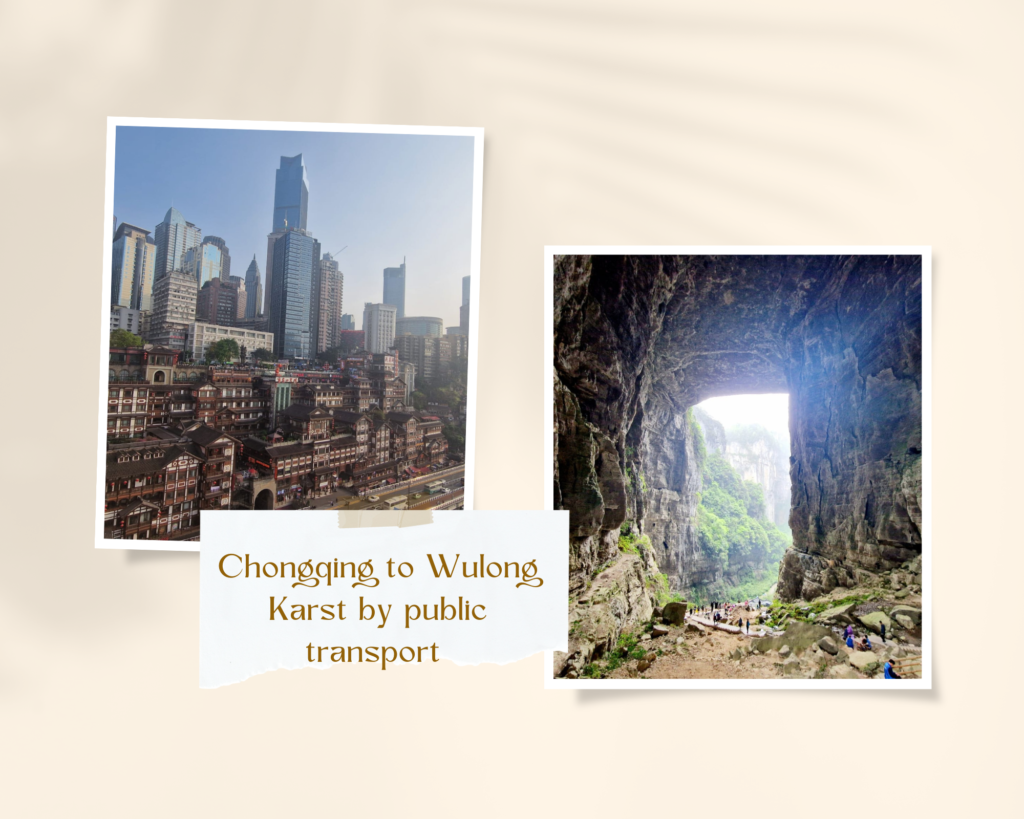
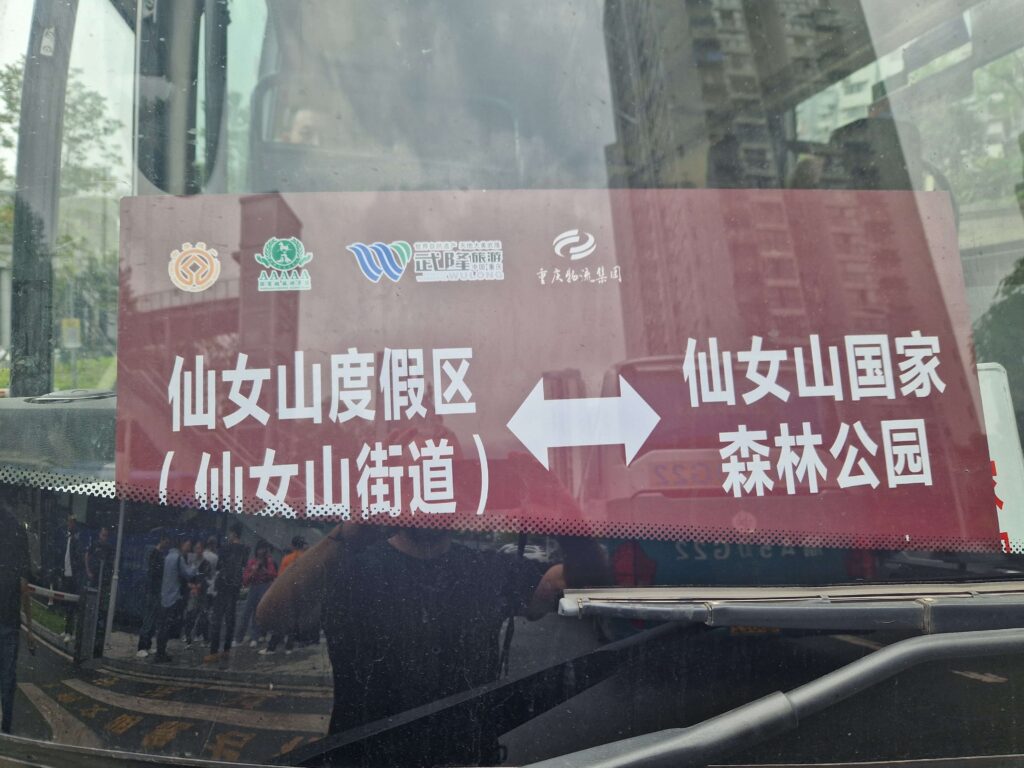
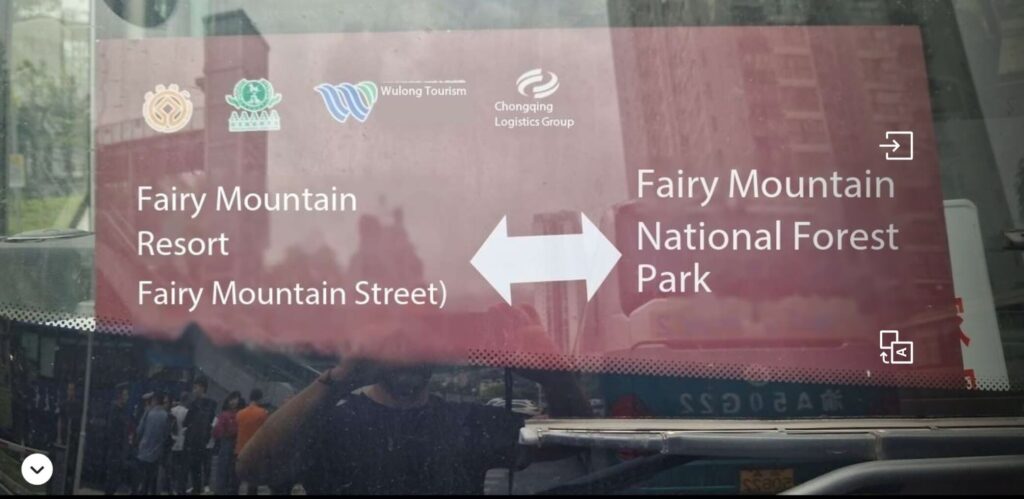




Thank you so so much for this comprehensive and useful guide! I’m off to Chongqing for 5 days in November with my brother and sister-in-law from HK. I am putting together some itinerary for us and this guide is perfect. I am saving this as favourite for further reference!
Thank you Louise, we are delighted to hear that and any other information you need just ask. We are always more than happy to help.
Thanks very much for this useful information. I and my friends are planning to go to Wulong and Chongqing early next month. Just wondering how to go to Furong Cave, Longshuixia Gap, and Fairy Mountain from Wulong Karst. Any idea?
Hey Ling, the bus we mention from Wulong goes to Fairy Mountain. Lots of options then once in fairy Mountain (taxi or bus) to get to Furong Cave, Longshuixia Gap,
Hello! Thank you so much for sharing! I planned to go to CQ this December and was wondering on the cheapest way to get to Wulong Karst and I found your website! It helped a lot! Definitely will try this way XD
Btw, I want to know when should you pay the bus? When you get in or get off the bus?
Thank you very much Gwen! Bit of a strange process in regards to payment, the bus took off and after 15 minutes he pulled in somewhere else to collect the fees! Have a fantastic time in Wulong Karst, it is amazing!
Thank you for your reply!
The payment process sounds like many bus routes here in my country..
Do you have to pay by cash? Or is it possible by Alipay?
I will enjoy Wulong Karst for sure, and if possible, I want to visit Fairy Mountain as well this trip. Hehe..
The snowy Fairy Mountain looks so amazing XD
Saw it on Google, and it seems it’s already snowing there from around 20th of December.. Really want to go if the time allows…
Thank you so much for this guide! I followed it and had a great time seeing the three bridges. Btw the entrance ticket is now 155rmb while the blue bus is still 10rmb.
Thank you so much for that information, appreciate that. we will add in the updated info to the article!